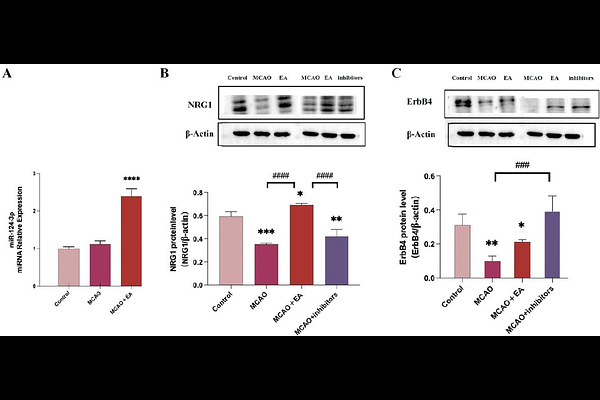Electroacupuncture promotes post-stroke motor recovery through miR-124-3p-mediated regulation of NRG1/ErbB4 signaling pathway

Electroacupuncture promotes post-stroke motor recovery through miR-124-3p-mediated regulation of NRG1/ErbB4 signaling pathway
Yu, D.; Chen, P.; Chen, X.; Lin, F.; Lin, Y.; Chen, N.; Wu, F.; Shao, B.
AbstractObjective: Electroacupuncture has demonstrated beneficial effects in post-stroke motor dysfunction, yet the molecular mechanisms underlying its therapeutic efficacy remain incompletely understood. This study aims to investigate whether electroacupuncture promotes post-stroke motor function recovery by modulating the interaction between miR-124-3p and the NRG1/ErbB4 signaling pathway, specifically exploring whether miR-124-3p directly targets NRG1 to regulate neural plasticity in a focal cerebral ischemia rat model. Methods: The ischemic stroke model was established by middle cerebral artery occlusion/reperfusion (MCAO/R) in adult rats. These rats were randomly divided into sham, model, electroacupuncture and model plus miR-124-3p inhibitor groups. The model group, electroacupuncture group and model plus miR-124-3p inhibitor group received EA intervention 24 h after modelling for 7 consecutive days. Behavioural function was assessed by Zea Longa score and mechanical pain rating. Hippocampal damage was detected by HE staining and neuronal apoptosis was observed by TUNEL staining. IL-1{beta} and IL-18 levels were measured by ELISA. PCR and Western blotting were used to detect the expression of miR-124-3p and inflammatory pathway proteins. The interaction between miR-124-3p and TLR4 was verified by dual-luciferase reporter assay. Results: Electroacupuncture improved motor function in rat model of MCAO/R, as evidenced by improved Zea Longa scores and decreased mechanical withdrawal thresholds. Electroacupuncture significantly attenuated neuronal damage and also inhibited the inflammatory response by decreasing IL-18 and IL-1{beta} levels (P < 0.001). Notably, electroacupuncture upregulated miR-124-3p expression (P < 0.0001) and activated the NRG1/ErbB4 signaling pathway in the hippocampus. When miR-124-3p was inhibited, NRG1 protein expression decreased while GABA expression tended to increase. Dual-luciferase reporter assays confirmed that miR-124-3p directly targets the 3\'UTR of NRG1 mRNA and regulates its expression at the translational level. These findings suggest that electroacupuncture may alleviate neuronal and axonal damage by modulating miR-124-3p/NRG1/ErbB4 signalling and regulating GABA release. Conclusion: Electroacupuncture can ameliorate motor dysfunction induced after brain I/R injury by targeting and modulating the NRG1-ErbB4 signaling pathway via miR-124-3p. These data are expected to provide new insights into the mechanisms of electroacupuncture for the prevention of potential targets for the recovery of motor dysfunction after stroke.